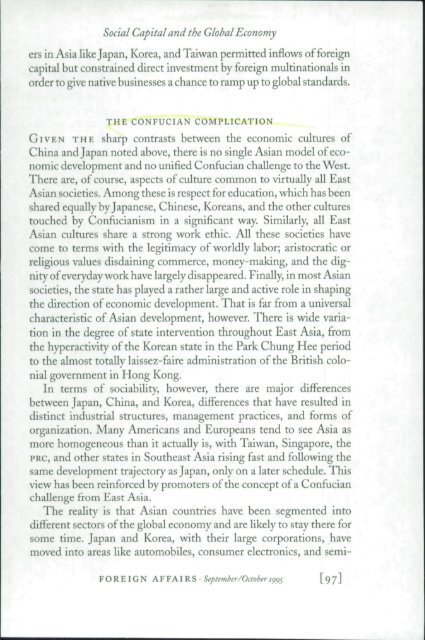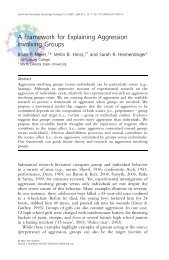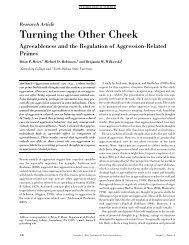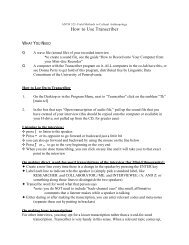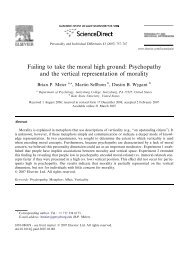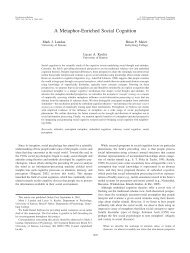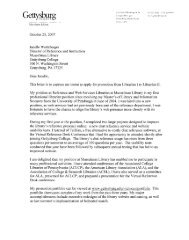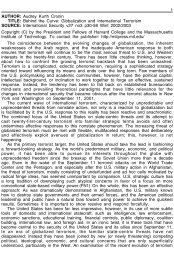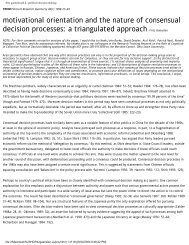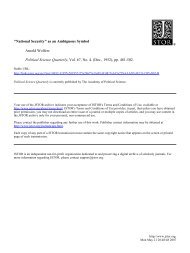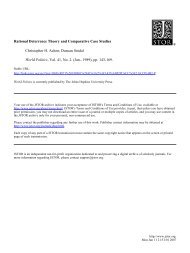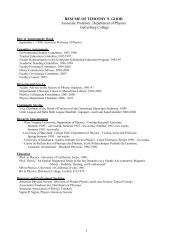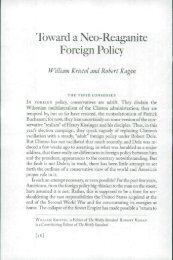Francis Fukuyama. 1995 "Social Capital and the Global Economy."
Francis Fukuyama. 1995 "Social Capital and the Global Economy."
Francis Fukuyama. 1995 "Social Capital and the Global Economy."
Create successful ePaper yourself
Turn your PDF publications into a flip-book with our unique Google optimized e-Paper software.
<strong>Social</strong> <strong>Capital</strong> <strong>and</strong> <strong>the</strong> <strong>Global</strong> <strong>Economy</strong><br />
ers in Asia like Japan, Korea, <strong>and</strong> Taiwan permitted inflows of foreign<br />
capital but constrained direct investment by foreign multinationals in<br />
order to give native businesses a chance to ramp up to global st<strong>and</strong>ards.<br />
THE CONFUCIAN COMPLICATION<br />
GIVEN THE sbarp contrasts between <strong>the</strong> economic cultures of<br />
China <strong>and</strong> Japan noted above, <strong>the</strong>re is no single Asian model of economic<br />
development <strong>and</strong> no unified Confucian challenge to <strong>the</strong> West.<br />
There are, of course, aspects of culture common to virtually all East<br />
Asian societies. Among <strong>the</strong>se is respect for education, which has been<br />
shared equally by Japanese, Chinese, Koreans, <strong>and</strong> <strong>the</strong> o<strong>the</strong>r cultures<br />
touched by Confucianism in a significant way. Similarly, all East<br />
Asian cultures share a strong work ethic. AH <strong>the</strong>se societies have<br />
come to terms with <strong>the</strong> legitimacy of worldly labor; aristocratic or<br />
religious values disdaining commerce, money-making, <strong>and</strong> <strong>the</strong> dignity<br />
of everyday work have largely disappeared. Finally, in most Asian<br />
societies, <strong>the</strong> state has played a ra<strong>the</strong>r large <strong>and</strong> active role in shaping<br />
<strong>the</strong> direction of economic development. That is far from a universal<br />
characteristic of Asian development, however. There is wide variation<br />
in <strong>the</strong> degree of state intervention throughout East Asia, from<br />
<strong>the</strong> hyperactivity of <strong>the</strong> Korean state in <strong>the</strong> Park Chung Hee period<br />
to <strong>the</strong> almost totally laissez-faire administration of <strong>the</strong> British colonial<br />
government in Hong Kong.<br />
In terms of sociability, however, <strong>the</strong>re are major differences<br />
between Japan, China, <strong>and</strong> Korea, differences that have resulted in<br />
distinct industrial structures, management practices, <strong>and</strong> forms of<br />
organization. Many Americans <strong>and</strong> Europeans tend to see Asia as<br />
more homogeneous than it actually is, with Taiwan, Singapore, <strong>the</strong><br />
PRC, <strong>and</strong> o<strong>the</strong>r states in Sou<strong>the</strong>ast Asia rising fast <strong>and</strong> following <strong>the</strong><br />
same development trajectory as Japan, only on a later schedule. This<br />
view has been reinforced by promoters of <strong>the</strong> concept ofa Confucian<br />
challenge from East Asia.<br />
The reality is that Asian countries have been segmented into<br />
different sectors of <strong>the</strong> global economy <strong>and</strong> are likely to stay <strong>the</strong>re for<br />
some time. Japan <strong>and</strong> Korea, with <strong>the</strong>ir large corporations, have<br />
moved into areas like automobiles, consumer electronics, <strong>and</strong> semi-<br />
FOREIGN AFFAIRS • September/Octoberi99s


